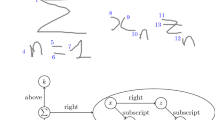Abstract
An interactive example-driven approach to graphics recognition in engineering drawings is proposed. The scenario is that the user first interactively provides an example of a graphic object; the system instantly learns its graphical knowledge and uses the acquired knowledge to recognize the same type of graphic objects. The proposed approach represents the graphical knowledge of an object in terms of its structural components and their syntactical relationships. We summarize four types of geometric constraints for knowledge representation, based on which we develop an algorithm for knowledge acquisition. Another algorithm for graphics recognition using the acquired graphical knowledge is also proposed, which is actually a sequential examination of these constraints. In the algorithm, we first guess the next component’s attributes (e.g., size, position and orientation) by reasoning from an earlier found component and the constraint between them, and then search for this hypothetical component in the drawing. If all of the hypothetical components are found, a graphic object of this type is recognized. For improving the system’s recognition accuracy, we develop a user feedback scheme, which can update the graphical knowledge from both positive (missing) and negative (mis-recognized) examples provided by the user for subsequent recognition. Experiments have shown that our proposed approach is both efficient and effective for recognizing various types of graphic objects in engineering drawings.
Similar content being viewed by others
References
“http://www.cvc.uab.es/grec2003/SymRecContest/images.htm”. GREC’03 Symbol Recognition Contest sample images
“http://www.symbols.com”. The world’s largest online encyclopedia of graphic symbols
“http://xmailserver.org/davide.html”. Ras2Vec 1.2, D. Libenzi, a freeware for vectorization
Cheng, T., Khan, J., Liu, H., Yun, D.Y.Y. A symbol recognition system. In: Proceedings of the ICDAR93 (1993)
Cordella, L.P., Foggia, P., Genna, R., Vento, M. Prototyping structural descriptions: an inductive learning approach. In: Proceedings of the SSPR, pp. 339–348 (1998)
Dori D., Liu W. (1999) Sparse pixel vectorization: an algorithm and its performance evaluation. IEEE Trans PAMI. 21(3): 202–215
Dori D. (1989) A syntactic/geometric approach to recognition of dimensions in engineering machine drawings. CVGIP 47(3): 271–291
Flickner M., et al. (1995) Query by image and video content: the QBIC system. IEEE Comput. 28(9): 23–32
Kasturi, R., Tombre, K. (eds.) Graphics Recognition: methods and applications (Lecture Notes in Computer Science, vol. 1072, Springer) (Selected papers from First International Workshop on Graphics Recognition, August 1995) (1996)
Lee J.K., Kim K. (1996) Geometric reasoning for knowledge-based parametric design using graph representation. Comput. Aided Des. 28(10): 831–841
Liu W., Dori D. (1998) A generic integrated line detection algorithm and Its object-process specification. CVIU 70(3): 420–437
Liu W., Dori D. (1998). Genericity in graphics recognition algorithms. In: Tombre K., Chhabra A. (eds). Graphics recognition: algorithms and systems, Lecture Notes in Computer Science, vol. 1389, Springer, Berlin Heidelberg New York, pp. 9–21
Liu W., Dori D. (1998) Incremental arc segmentation algorithm and its evaluation. IEEE Trans. PAMI 20(4): 424–431
Liu, W. Example-driven graphics recognition. In: Proceedings of the SSPR2002 (Structural, Syntactic, and Statistical Pattern Recognition, LNCS, vol. 2396), pp. 168–176 (2002)
Llados J., Valveny E., Sanchez G., Marti E. (2002) Symbol Recognition: Current Advances and Perspectives. LNCS, vol. 2390, pp. 104–127. Springer, Berlin Heidelberg New York
Muller, S., Eiceler, S., Rigoll, G. Image database retrieval of rotated objects by user sketch In: Proceedings of the IEEE Workshop on Content-Based Access of Image and Video Libraries, pp. 40–44 (1998)
Okazaki A., Kondo T., Mori K., Tsunekawa S., Kawamoto E. (1988) An automatic circuit diagram reader with loop-structure-based symbol recognition. IEEE Trans. PAMI 10(3): 331–341
Phillips I.T., Chhabra A.K. (1999) Empirical performance evaluation of graphics recognition systems. IEEE Trans. PAMI 21(9): 849–870
Samet H., Soffer, A. A legend-driven geographic symbol recognition system. In: Proceedings of the ICPR, pp. 350–355 (1994)
Schank R.C., Abelson R.P. (1977) Scripts, Plans, Goals and Understanding. Erlbaum, Hillsdale
Segen J. (1989). From features to symbols: learning relational models of shape. In: Simon J.C. (eds). From Pixels to Features. Elsevier, Amsterdaw pp. 237–248
Tabbone, S., Wendling, L., Tombre, K. Indexing of technical line drawings based on F-signatures. In: Proceedings of the ICDAR (2001)
Tombre, K. Analysis of engineering drawings: state of the art and challenges. In: Graphics Recognition: Algorithms and Systems, LNCS, vol. 1389, pp. 257–264. Springer, Berlin Heidelberg New York (1998)
Vaxiviere P., Tombre K. (1992) Celestin: CAD conversion of mechanical drawings. IEEE Comput. Mage 25(7): 46–54
Winston P.H. (1975). Learning structural descriptions from examples. In: Winston P.H. (eds). The Psychology of Computer Vision. McGraw-Hill, New York, pp. 157–209
Wong A.K.C., You M. (1985) Entropy and distance of random graphs with applications to structural pattern recognition. IEEE Trans. PAMI 7(5): 599–609
Yan, L., Liu, W. Engineering drawings recognition using a case-based approach. In: Proceedings of the ICDAR, pp. 190–194 (2003)
Yan, L., Liu, W. An Interactive approach to graphics recognition in engineering drawings. In: Proceedings of the GREC pp. 170–181 (2003)
Author information
Authors and Affiliations
Corresponding author
Additional information
This paper is an extension of our papers published in ICDAR2003 and GREC2003.
Rights and permissions
About this article
Cite this article
Wenyin, L., Zhang, W. & Yan, L. An interactive example-driven approach to graphics recognition in engineering drawings. IJDAR 9, 13–29 (2007). https://doi.org/10.1007/s10032-006-0025-x
Received:
Revised:
Accepted:
Published:
Issue Date:
DOI: https://doi.org/10.1007/s10032-006-0025-x




